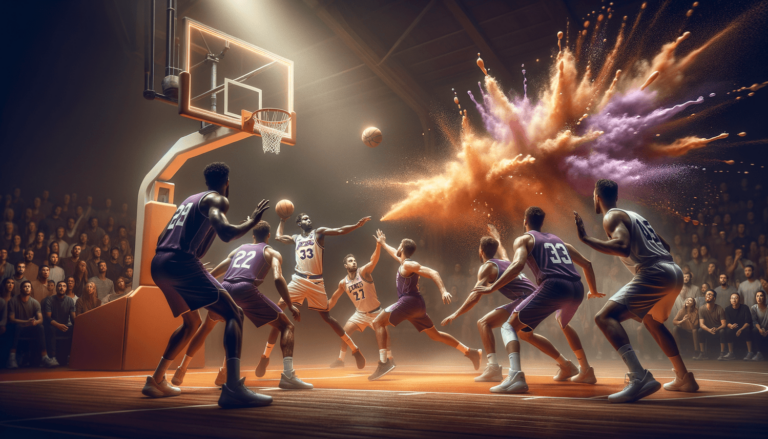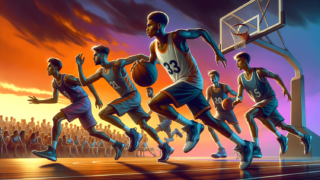
Hack-a-Shaq Strategy: Is It Effective?
Written by: Basketball Universe
Last updated:

In the riveting world of basketball, strategies often ebb and flow like the tides of the ocean, but one tactic has lingered long enough for fans to have a love-hate relationship with it: the Hack-a-Shaq. Coined after the illustrious Shaquille O’Neal and his infamous free-throw woes, the Hack-a-Shaq leverages the weakest link in a player’s skill set for the opponent’s maximum gain. But is it truly an effective game-changer, or simply a controversial move that occasionally pays off? Fasten your sneakers and dive deep into the debate surrounding the Hack-a-Shaq strategy, as we break down its potential impact on both the game and the players within.
Hack-a-Shaq Strategy: Is It Effective?
The Hack-a-Shaq strategy, named after Shaquille O’Neal’s struggles with free throws, intentionally fouls a poor free-throw shooter to force them to take shots they are likely to miss. While this strategy can be effective in certain situations, when utilized properly, it also has its downsides, such as disrupting the flow of the game and reducing the morale of players. The effectiveness of the Hack-a-Shaq strategy largely depends on the specific players involved and the context within the game, making it a situational and somewhat controversial tactic within basketball.
Unraveling the Hack-a-Shaq Strategy
Before we delve into the nitty-gritty of the strategy’s effectiveness, it’s crucial to understand the fundamentals of the Hack-a-Shaq approach. The tactic revolves around intentionally fouling an opposing player with subpar free-throw shooting skills, compelling them to earn points from the free-throw line rather than executing more traditional game plays.
Behind the Name
The strategy was named after the legendary NBA player Shaquille O’Neal, whose weaker free-throw performance was a well-known vulnerability. Coaches caught on to this and began employing intentional fouling as a tactic against Shaq, giving birth to the infamous moniker.
Assessing the Strategy’s Effectiveness
Now that we’ve laid the groundwork, let’s explore the pros and cons of implementing the Hack-a-Shaq strategy, breaking down the factors that determine whether it’s truly a game-changer or a hit-or-miss tactic.
Advantages of the Hack-a-Shaq
- Minimizing Points: By fouling poor free-throw shooters and forcing them to the line, teams have the potential to limit opponents’ scoring opportunities, preventing easy layups or higher-percentage shots.
- Disrupting Rhythm: For teams on a hot streak, utilizing the Hack-a-Shaq can interrupt their momentum, potentially causing the pace and the rhythm of the game to be thrown off balance.
- Buying Time: Under certain scenarios, intentionally fouling an opposing player may provide the fouling team time to regroup, strategize, or give pivotal players a brief break.
Drawbacks of the Hack-a-Shaq
- Unpredictable Results: The efficacy of the Hack-a-Shaq is reliant on the fouled player’s missed free throws. If they’re making their shots, the strategy backfires and results in gratuitous points for the opposition.
- Fouling Limit: It’s critical to remember that basketball rules stipulate a maximum number of fouls permitted per player; the possibility of key players fouling out of the game or entering foul trouble can have significant consequences.
- Psychological Impact: The Hack-a-Shaq may demoralize the fouled player, but it can also wear on the fouling team, causing doubt, frustration, and self-inflicted pressure.
Numbers Don’t Lie: Statistical Analysis
With the pros and cons in mind, let’s dive into some data-backed evidence to gain a clearer perspective on whether the Hack-a-Shaq strategy is worth employing.
Free-Throw Success Rate
When assessing free-throw percentages, several points must be factored in for a balanced analysis. Consider the typical free-throw shooting percentage for an NBA player, which usually hovers around 75%. If a player’s shooting percentage lies substantially below this figure, applying the Hack-a-Shaq may be warranted. Conversely, if the player demonstrates improvement in their free-throw performance, the strategy may lose its effectiveness.
Impact on Pace and Scoring
An essential metric to examine is how the Hack-a-Shaq approach influences a team’s offensive and defensive effectiveness. Studies have revealed that employing the strategy can impact the pace of the game, slowing down high-scoring opponents and disrupting their offensive rhythm. This can potentially shift the momentum in favor of the team that initiates the fouling.
Context Matters: When to Use the Hack-a-Shaq
It’s vital to comprehend that the Hack-a-Shaq is a situational strategy that relies heavily on context. Timing and circumstance play an irreplaceable role in determining whether fouling a player will be a masterstroke or a wasted opportunity. Let’s explore some of these scenarios in greater detail.
Late-Game Scenarios
As games wind down and the clock works against teams, leveraging the Hack-a-Shaq during critical situations may be advantageous. For example, if a team is trailing and needs to regain possession, intentionally fouling a poor free-throw shooter can help stop the clock, disrupt the opponent’s offensive flow, and increase the likelihood of gaining valuable possession.
Trailing by a Small Margin
When contending with a narrow deficit, every point counts. Engineering a Hack-a-Shaq attack on an opponent can potentially swing the game’s outcome, particularly when facing high-scoring players who are more likely to connect from the field. By fouling a weaker free-throw shooter, the risk of losing the game may be minimized.
Opponent’s Star Player in Foul Trouble
If the opposition’s key player is already in foul trouble or close to fouling out, the Hack-a-Shaq strategy may generate additional pressure on their performance. This can force the opponent to either alter their gameplay or risk losing their star player, which can ultimately open up opportunities for the fouling team.
The Hack-a-Shaq’s Impact on the Game
Beyond its strategic components, the Hack-a-Shaq generates polarizing opinions among fans, players, and coaches due to its impact on the game’s appeal and entertainment value.
Speed of Play
By employing the Hack-a-Shaq, the game’s flow is frequently interrupted, slowing the pace, and making it less enjoyable for viewers. This disruption of the game’s rhythm has sparked conversations about rule changes and restrictions on intentional fouling within the NBA.
Effect on Players
The psychological toll of the Hack-a-Shaq tactic can be significant for both the fouled player and the fouling team. For the targeted player, it can exacerbate the pressure and lead to diminished confidence. For the fouling team, it can create desperation or frustration over struggling to regain control of the game.
A Multifaceted Judgement
The effectiveness of the Hack-a-Shaq cannot be gauged solely based on a single variable. The strategy’s success hinges on diverse factors, from the quality of the free-throw shooter’s performance to the overall game context. While the tactic can provide certain advantages when implemented prudently, the drawbacks it presents can also backfire on the fouling team.
Adaption and Evolution
It’s crucial to take into account the adaptability of players and coaching staff. As NBA organizations have become more skilled and astute in their tactics, both offensive and defensive strategies have been refined over time to counter the Hack-a-Shaq.
Looking Ahead
The ongoing debate about the Hack-a-Shaq’s effectiveness and impact on the game will always fluctuate within the realm of basketball. Nevertheless, as players continue to evolve and refine their skills, it remains to be seen how long the strategy will retain a stronghold in the repertoire of competitive techniques. To truly comprehend the effectiveness of the Hack-a-Shaq, all aspects must be weighed, examined, and contextualized on a case-by-case basis.
Rule Modifications and the NBA’s Response to Hack-a-Shaq
Considering the contentious impact of the Hack-a-Shaq strategy on the game’s speed and aesthetic, the NBA has undertaken efforts to curb the excessive use of this tactic. They have taken into account the fans’ desire for an exciting, fast-paced contest and the potential harm the approach might impose on the sport’s entertainment value.
Off-the-Ball Fouls
In 2016, the NBA Board of Governors approved rules modifications that targeted off-the-ball fouls during the last two minutes of each period, intending to reduce the prevalence of the Hack-a-Shaq. Previously, the regulation only applied during the final two minutes of the fourth quarter. Under the revised rules, the fouled team receives one free throw, and they maintain possession of the ball. This rule change aimed to deter teams from exploiting intentional fouls in the majority of the game.
Developing Players’ Free-Throw Shooting Skills
Improving free-throw shooting abilities has become a focal point for players and coaching staff alike, given its potential influence on game outcomes. In this regard, the Hack-a-Shaq strategy has shed light on an important aspect of basketball skill development.
Coaching Techniques and Drills
Coaches often implement an array of techniques and drills to refine a player’s free-throw shooting prowess. From altering posture to focusing on follow-through, there is a multitude of strategies employed to elevate a player’s success rate from the charity stripe. Practices may also incorporate free-throw repetitions under pressure, simulating in-game stress for more accurate results.
Psychological Aspects
Free-throw performance is not entirely about technique; the psychological component plays an essential role. Sports psychologists and mental skills trainers are increasingly common in the NBA, assisting players in honing mental toughness and coping strategies to manage the high pressure these situations often generate.
Alternative Strategies to the Hack-a-Shaq
For teams seeking alternatives to the Hack-a-Shaq approach, there are several other defensive strategies that can be applied to disrupt opponents’ rhythm and scoring opportunities.
Defensive Switching
Effective defensive switching promotes better communication among teammates, helps counteract faster-paced offenses, and makes it challenging for opponents to exploit mismatches. Training teams for seamless switching allows them to adapt to various situations, mitigating the need for intentional fouling.
Zone Defense
Zone defense provides an organized system for covering the court, concentrating on specific areas rather than individual matchups. Implementing a zone enables teams to close out on shooters, disrupt passing lanes, and exploit an opponent’s offensive weakness, reducing the reliance on tactics like the Hack-a-Shaq.
Full-Court Press
A full-court press is a high-pressure defensive strategy applied throughout the length of the court. By implementing this approach, teams can impede their opponents’ ability to bring the ball up the court and establish their offense, thereby limiting scoring opportunities and creating turnovers.
Frequently Asked Questions (FAQ)
In this section, we’ve compiled a list of common questions related to the Hack-a-Shaq strategy and its overall effectiveness in basketball. Read on as we provide succinct, NLP-style answers to make it easier for you to digest and understand the finer nuances of this intriguing tactic.
1. What exactly is the Hack-a-Shaq strategy?
The Hack-a-Shaq strategy is a basketball tactic where an opposing team intentionally fouls a weak free-throw shooter, forcing them to the free-throw line to take shots they’re likely to miss in order to limit their scoring opportunities.
2. Why is the strategy called “Hack-a-Shaq”?
It’s named after NBA legend Shaquille O’Neal, who had a well-known weakness in free-throw shooting. Coaches started intentionally fouling Shaq to exploit this vulnerability, hence the term “Hack-a-Shaq” was born.
3. Is the Hack-a-Shaq strategy effective in limiting opponents’ scoring?
It can be effective when used strategically by fouling a poor free-throw shooter, as it may limit scoring opportunities and disrupt the opposing team’s rhythm. However, success largely depends on the specific players and situational context within the game.
4. How can the Hack-a-Shaq strategy backfire?
It may backfire if the fouled player makes their free throws. Additionally, it can lead to fouling limits for key players on the fouling team and psychologically impact both the fouled player and the fouling team negatively.
5. What’s the typical free-throw shooting percentage for an NBA player?
The average free-throw shooting percentage for an NBA player usually hovers around 75%. Players with substantially lower free-throw percentages may be targeted with the Hack-a-Shaq strategy.
6. How has the NBA responded to the Hack-a-Shaq strategy?
The NBA has implemented rule modifications, such as targeting off-the-ball fouls in the last two minutes of each period, to curb the excessive use of the Hack-a-Shaq strategy and maintain the game’s attraction and entertainment value.
7. How can players improve their free-throw shooting skills?
Players can work with coaches to develop proper shooting techniques, form, and follow-through. Additionally, sports psychologists and mental skills trainers can help players develop mental toughness and coping strategies to handle pressure in free-throw situations.
8. Are there alternative defensive strategies to the Hack-a-Shaq?
Yes, alternative strategies include defensive switching, zone defense, and full-court press. These tactics aim to disrupt opponents’ scoring options, create turnovers, and exploit opponents’ weaknesses more strategically.
9. Can the Hack-a-Shaq strategy be used at all levels of basketball?
Yes, the Hack-a-Shaq strategy can be employed at various levels of basketball, including college and high school games, as long as the league’s rules and regulations permit intentional fouling as a tactic.
10. How does the Hack-a-Shaq strategy impact the viewing experience for fans?
It can slow down the pace of the game due to frequent stoppages, disrupt the natural flow, and decrease the overall entertainment value for fans. These are contributing factors to the debate surrounding the strategy and calls for rule changes.
Featured Posts
- No pillar pages found.





